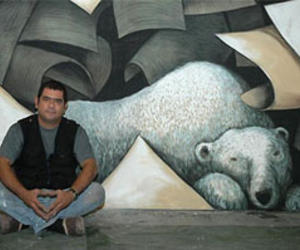Carlos René Aguilera’s Recent Works
- Submitted by: manso
- Arts and Culture
- 01 / 24 / 2011

By: Yelanys Hernandez Fuste. Obras Recientes, the latest exhibition of plastic artist Carlos René Aguilera Tamayo (1965) is an implausible world increasingly connected to reality. This exhibition was inaugurated on January 15 in the gallery La Confronta de la UNEAC in his native Santiago de Cuba.
Thanks to emails, Carlos René has sent me his works. There is in his work a universe built entirely in mixed media on canvas.
For specialist Raul Ruiz Miyares, these art works show “our lives, our sorrows and joys of living in a place where we have the ability to laugh at our misfortunes, assuming that problems will be solved.
Meanwhile, the author asserts that "these works are part of an investigation about plastic works around the islands in general, but from another perspective contrary to what it is usually done. In my case, from the sea towards the interior of the islands, because I think it’s the real struggle scenario, escape and reunion is within the islands themselves, and within the island it's every man or woman”.
Carlos René’s futuristic look combined with his perceptions of past and present; hence, in these sixteen pieces the public does not feel the pulse of time, as the artist imposes an urgent concern to each of his works.
When you see Archipiélago, you notice the artist desire to clarify the fate of characters that he recreates. In La creación, he describes a very Caribbean view of human life emergence, without leaving the concept of Michelangelo in the Sistine Chapel.
Carlos René reflects an interest to show the region where he lives with historical contemplation by dialoguing with earlier stages in La teoría de las cuerdas. The author portrays the harshness of slavery and the faces of sadness and surrender to such oppression.
But Pasadizos is one of the most original ideas in Obras Recientes.
Such creativity is also seen in Tres juanes y un entuerto —winner of the UNEAC East Room Award in 2010— as well as in Nave con viento propio, Desembarco, Preludio para un desenredo, Cuerdas y teorías, and Penélope.
The artist always shows the academic knowledge acquired during his time at the Art Academy José Joaquín Tejada in Santiago Cuba and the Superior Institute of Art, from which he graduated in 1984 and 1989, respectively.
Carlos René has the distinction of the Cuban Culture and other awards as important as the Gold Medal at the Second and Third Biennial of Central America and the Caribbean, taking place in Santo Domingo, Dominican Republic, in 1994 and 1996 respectively. He was also honored in 1992 at the National Hall of Laureates.
The painter has over 140 personal and 50 group exhibitions. One of the most recent was Inventario, which was seen in Havana, housed in the Ludwig Foundation of Cuba, during the XX Biennial of Havana.
It is gratifying then to meet with these fantastic works of Carlos René. He tests the concept of recency, because it is important to him to announce what he lived.
Cubasi Translation Staff
Comments